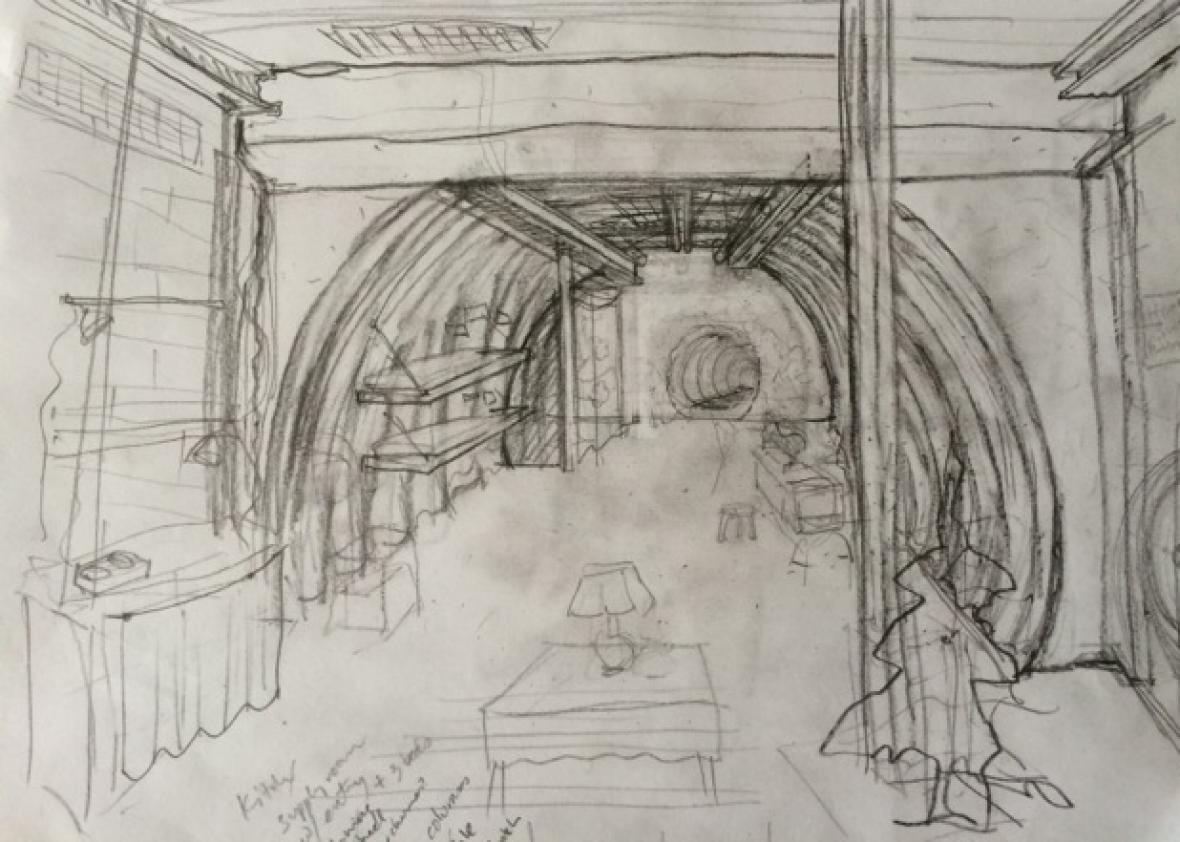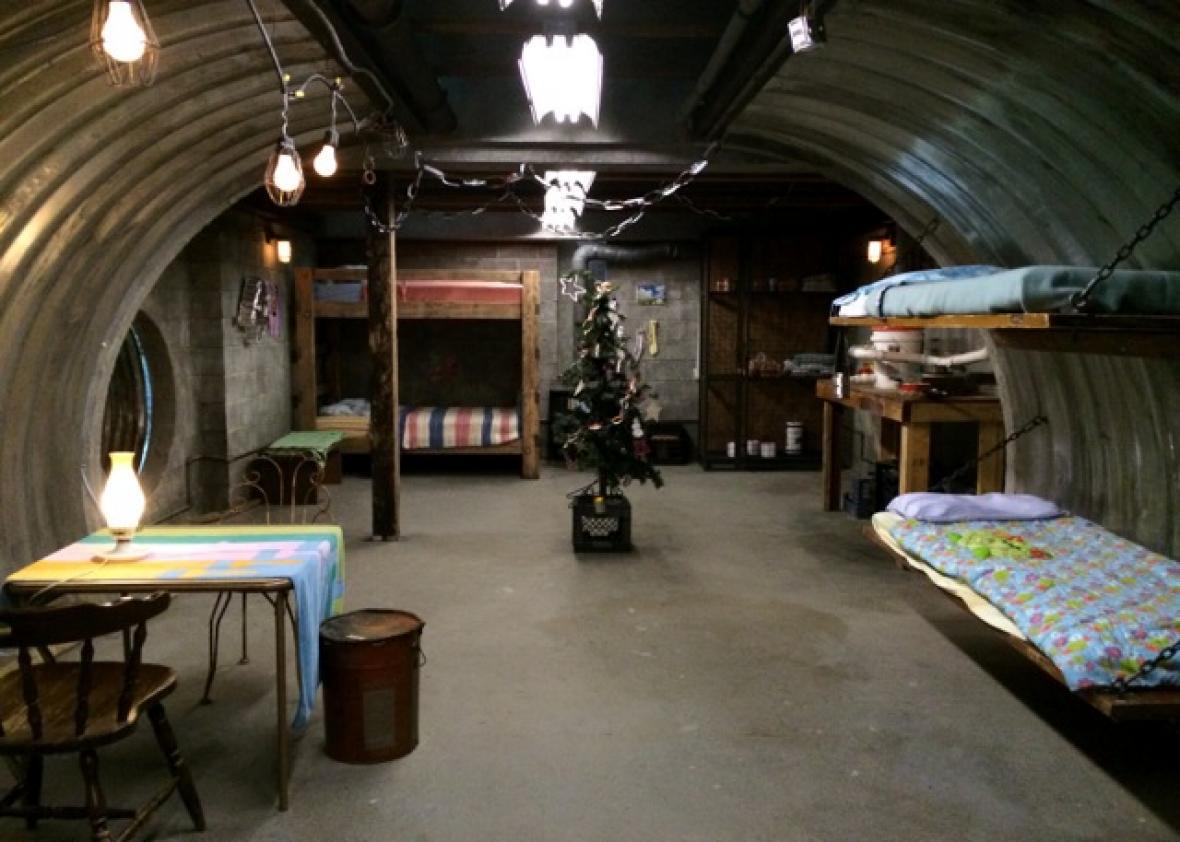When Unbreakable Kimmy Schmidt returns for its second season on April 15, Kimmy will continue to adapt to life as a New Yorker—but the show will keep revisiting her darker days through flashbacks to the years she spent trapped in a bunker with three other women and the cultish reverend who kidnapped them. The bunker itself is something we only see in glimpses, but it took a lot of research from the show’s production design team. After all, it’s no easy feat to design an underground dungeon that contains kidnapped women but still manages to be a backdrop for comedy. The bunker’s design even shaped a part of how Season 1’s narrative played out: For example, the Mystery Crank that powered the leader’s private room was initially just a random part of the set, inspired by visual elements the production design team saw in real-life survivalists’ bunkers. It was only after actors arrived on set and started looking for things to play with that writers considered giving the prop narrative meaning.

Teresa Mastropierro
Teresa Mastropierro, the show’s production designer, said that she and her team didn’t know very much about the details of the show or its characters when working on the bunker for the pilot. As a jumping-off point, they were told to research Warren Jeffs, the polygamist former president of the Fundamentalist Church of Jesus Christ of Latter-Day Saints who was convicted of aggravated sexual assault and sexual assault of a child in 2011. As she researched Jeffs, Mastropierro was most struck by the strong bond that formed among his sister wives. That extremely tight relationship was something Mastropierro wanted to express about Kimmy and her female bunker mates. The shelter structure is designed to look very utilitarian, but the women’s possessions and adornments—like all of their handmade Christmas decorations, as seen in the show’s pilot—are what give the space its semblance of warmth.
The bunker itself had two other sources of inspiration, Mastropierro said, besides Jeffs: survivalist bunkers and the movie Brazil. Examining real survivalists bunkers introduced an element of practicality to the structure, and Brazil inspired a few absurdist quirks.
“We did a lot of research on survivalists,” Mastropierro said. “There are many websites from people who are just certain that that day is going to come when they’ll have to go underground to survive for a few years—or forever—so that was pretty eye-opening to me. There are lots of shelters people have built, and they’re proud to show you.”
The survivalists contributed a lot of practical ideas for the show’s bunker—including the need for things like sustainable power and air and water filtration. This led Mastropierro and her team to add a generic-looking crank to the set as they “started looking into what we wanted to use to make it obvious that somebody had actually thought this through and planned to be down there for some time.” They bought the crank off the internet, assembled it, and stuck it on a wall. When the actors walked into the set, they started interacting with it, looking for actions they could do on screen to make the place come alive. They started turning the crank, “and it sort of became a thing, and developed itself into part of the story,” Mastropierro said.
Mastropierro noted that some real-life bunker-ers had spared no expense, decking out their doomsday dens with things like leather couches and flat-screen TVs. As Mastropierro put it, “They’re waiting for the end of the world in style.” That might explain the penchant Hamm’s character has for gratuitous luxuries. When the women he’d abducted finally invade his private room in search of any evidence that could convict him, they discover a post-apocalyptic paradise, complete with neon signs, a TV, a popcorn machine, a jukebox, and more. To design that set, Mastropierro said the production team “literally came up with a list of things that use a lot of electricity, and that would obviously need to be powered.” By then, they already knew the women would discover that the Mystery Crank was actually just a power source for all of the reverend’s electronic junk. “By that point in the story arc,” Mastropierro explained, “we went for it. We said, ‘Anything that lights up or moves.’ ”
“We were trying to make [the bunker] a place that you wouldn’t want to be,” Mastropierro said. The bunker itself—at least, the part the women had access to—is cold and uninviting. But when they started living there, they brought it to life. That’s why we see so many decorative elements the women have made from what they had—toilet paper tubes, markers, and soup can labels. And those touches achieve a tricky balance: They help make this grim scenery cheerful and quirky enough to work as a set for a comedy. Ironically enough, outside the show’s context, Mastropierro noted that its more fun visual elements—like the curved tube shapes of its walls—have made it a favorite play place among crewmembers’ children. In the context of the show, it’s the women themselves who make living in the bunker tolerable. “Because that’s the spirit behind all of it,” Mastropierro said. “They were indomitable.”
